Surface Pro 3 review: Everything you need to know
Microsoft may have just fixed Surface Pro 3 battery issue
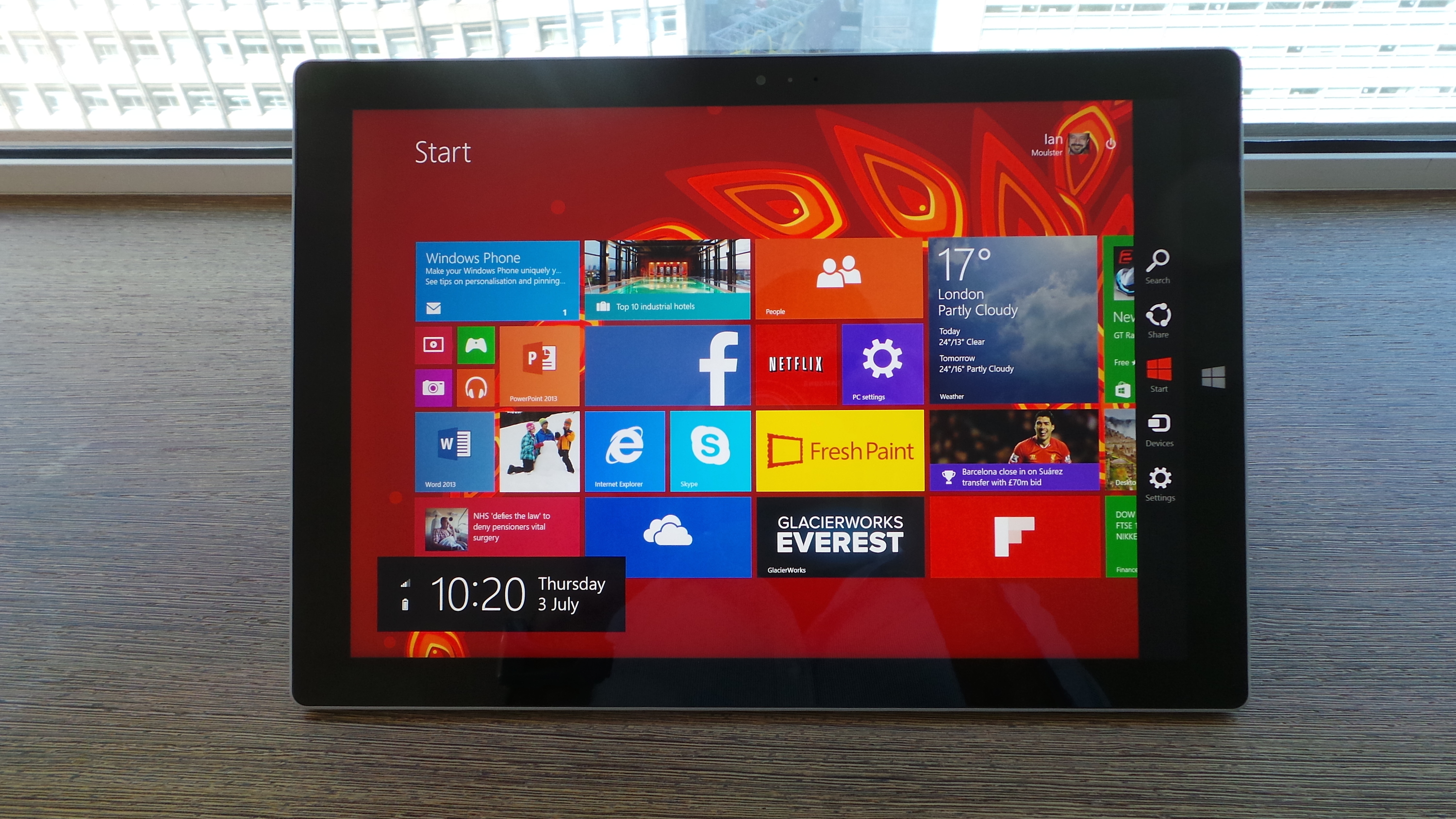
Microsoft combines the portability of a tablet with the raw power and input of a laptop. Despite its imperfections the Surface Pro 3 manages to live up to the claim of being a hybrid.
-
+
Superb screen; Excellent pen integration; Portable form factor, Good performance; Flexible kickstand
-
-
Type Cover not included; Windows scaling problems; Battery life isn’t good enough; Difficult to repair
Microsoft is betting big on the hybrid revolution with its range of Surface devices. The Surface Pro 3, for example, can apparently replace both your laptop and your tablet. However, while there are definite advantages to the hybrid approach, you should also be prepared to make some compromises.
For example, the Pro 3 offers laptop-like performance with a choice of Core i5/i7 processors and up to 8GB of RAM. On the flip-side, port selection is limited to a single USB connection, a microSD card reader and mini-DisplayPort because of space/weightconstrictions. Then there's battery life, which is short of the double-digits you'd expect from a power-efficient tablet.
However, the Pro 3 could still be the right option for you depending on how you want to work.
Latest News
31/08/2016: Microsoft may have fixed the Surface Pro 3's battery problems by rolling out a new update to the tablet computer.
The company said on its forum: "Thanks for your continued patience here. We have now completed our testing of the update and it has passed our quality assurance process. The update, "System firmware update - 8/29/2016", is now available to install from Windows update."
It warned that before installing the update users should ensure their device is plugged in. Any device being updated should have at least 40% battery life before attempting the update, it continued.
"v38.10.90.0 corrects an error that may occur on a limited number of Surface Pro 3 devices where the full charge capacity of the battery is misreported to the operating system and device firmware," Microsoft said in the changelog. "This update corrects the firmware component that functions as a "fuel gauge" so that the battery capacity is accurately reported."
Apparently, the battery problem is related to an error that "causes the full charge capacity of the battery to be misreported to the operating system and device firmware." It is a safety measure to stop the battery from overheating when it reaches fully charged capacity.
Microsoft said that it could take a few charging cycles for the issue to be completely fixed though, so users should not expect it to be sorted as soon as they install the update.
28/07/2016:Battery problems with the Surface Pro 3 appear to be a software issue, Microsoft has said.
Users whose devices are powered by the Simplo battery have had their battery life drained due to a fault, but Microsoft believes it has found an inexpensive solution.
On its Answer forum (spotted by ZDNet), Microsoft said: "We are aware of some customers reporting a scenario with their Surface Pro 3 batteries in which the system is reporting lower battery capacity than expected. We've isolated this to a limited number of customers experiencing this issue.
"Based on our investigations we can confirm that it is not an issue with the battery cells, and we believe this is something that can be addressed via software."
However, it is not clear when Microsoft will resolve this with a software update. "We're working through the details of how we deliver that," Microsoft also said.
Alternative Surface devices
Before we dive into the full Surface Pro 3 review, we should mention the rest of the Surface family.Microsoft has now fleshed out its Surface range with a product in virtually every bracket.
On the more affordable end of the spectrum is the Surface 3, which makes up for its comparatively underpowered specs by being the cheapest in the range.
The Surface Pro 3 itself has now been superseded by the Surface Pro 4. Microsoft has made some substantial improvements to the newer model, including a vastly upgraded TypeCover keyboard and new stylus technology.
The company has also released its first-party MacBook-killer, the Surface Book. With another detachable screen and an Nvidia GeForce graphics card, it's a pretty impressive beast indeed.
Microsoft isn't without competition though; Apple is putting up a fight with its own tablets and notebooks. Click here to read our head-to-head comparisons of the iPad Pro and the Surface Pro 3, as well as the iPad Pro versus the Surface Pro 4.
Display & design
The Surface Pro 3 has a stunning 12in screen. Its unique 3:2 aspect ratio coupled with the cover means it resembles a legal pad or large diary when closed. You get the impression it's sitting there waiting for you to fill the pages of OneNote with ideas and diagrams.
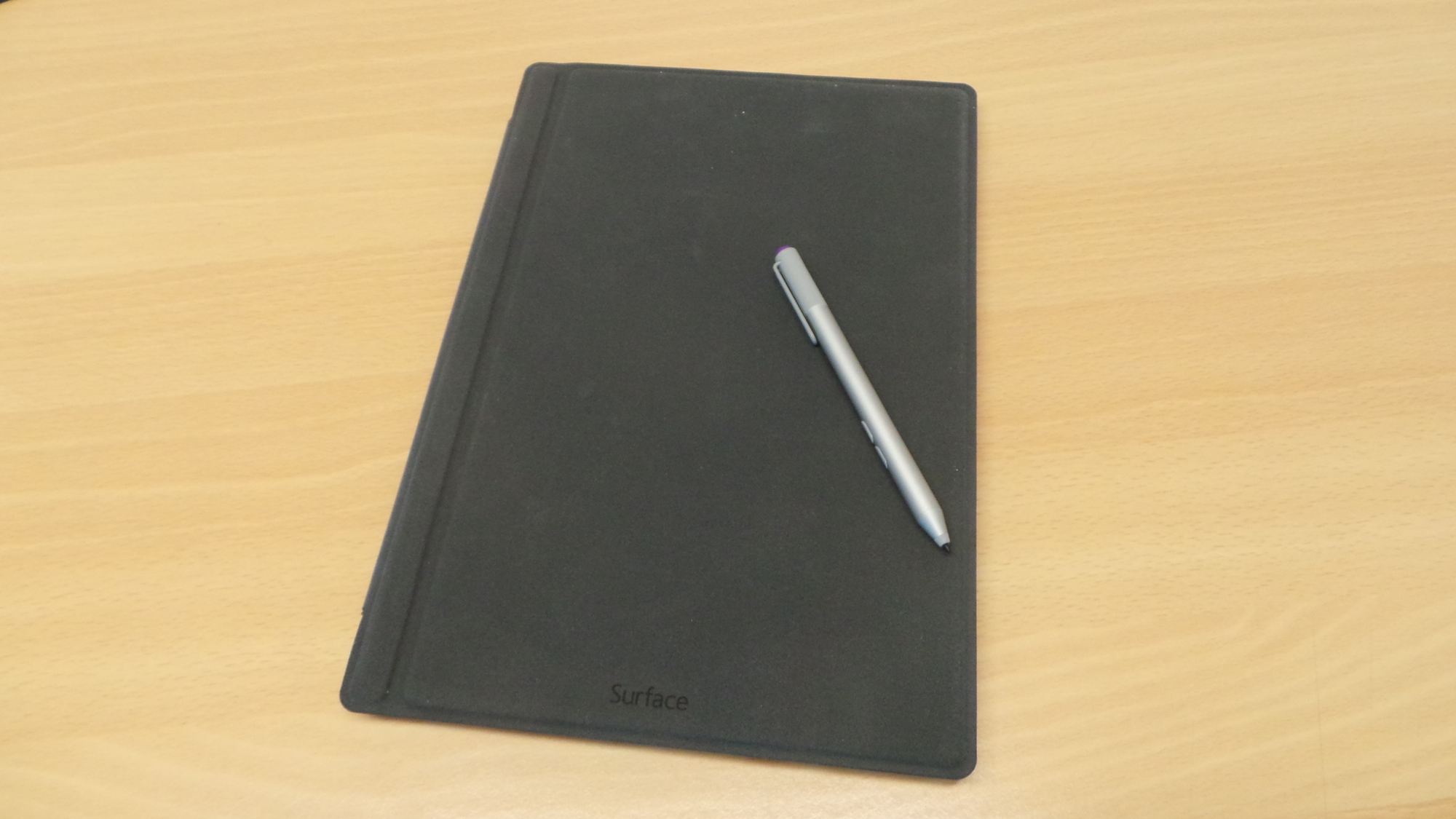
Microsoft has cranked up the resolution to 2160 x 1440. This produces clear, detailed images and also a rich palette of colours. It's right up there with the Retina Display on the iPad Air.
Then there's the size. The large screen means the device is edging more towards laptop territory. As such, web browsing and multimedia playback are a joy. It's also got enough space to place two apps together side-by-side on the screen, which is incredibly useful for those of us who have to multi-task.
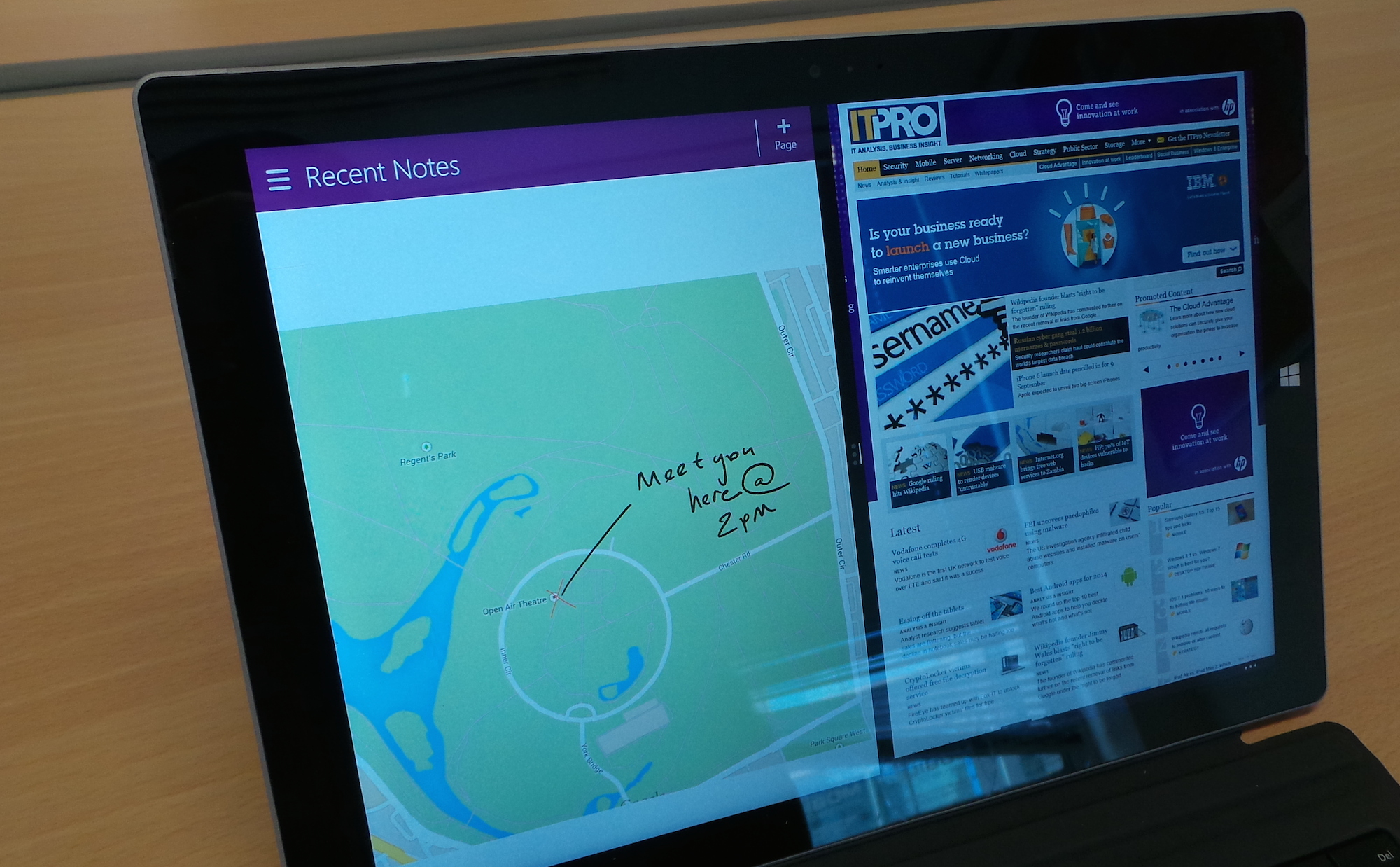
That said, the Pro 3 is not perfect. Cramming three million pixels into such a relatively small surface area poses problems, especially when software is not optimised to make use of them. The Surface Pro 3 exhibits the same scaling issues that have plagued other high-res Windows 8.1 devices and icons and text can be minuscule in desktop mode.
The first thing you should do is go to PC Setting > Display and then toggle the Size of application to Larger'. This makes all the Live Tiles, Settings and Charms menus easier to see. Unfortunately, it doesn't do anything to improve the desktop experience and is something Microsoft really needs to fix as the majority of power users will be spending their time in this mode.
Pen input
One of the highlights - and there are many - of the Surface Pro 3 is the pen input. A lot of thought has gone into the design here and the way in which the pen interacts with the device.
The tablet promises a natural writing experience, acting as a pen and paper replacement. It's made from a single piece of aluminum and looks and feels like a fountain pen instead of a plastic twig you'd have found shipped with the device's predecessors.
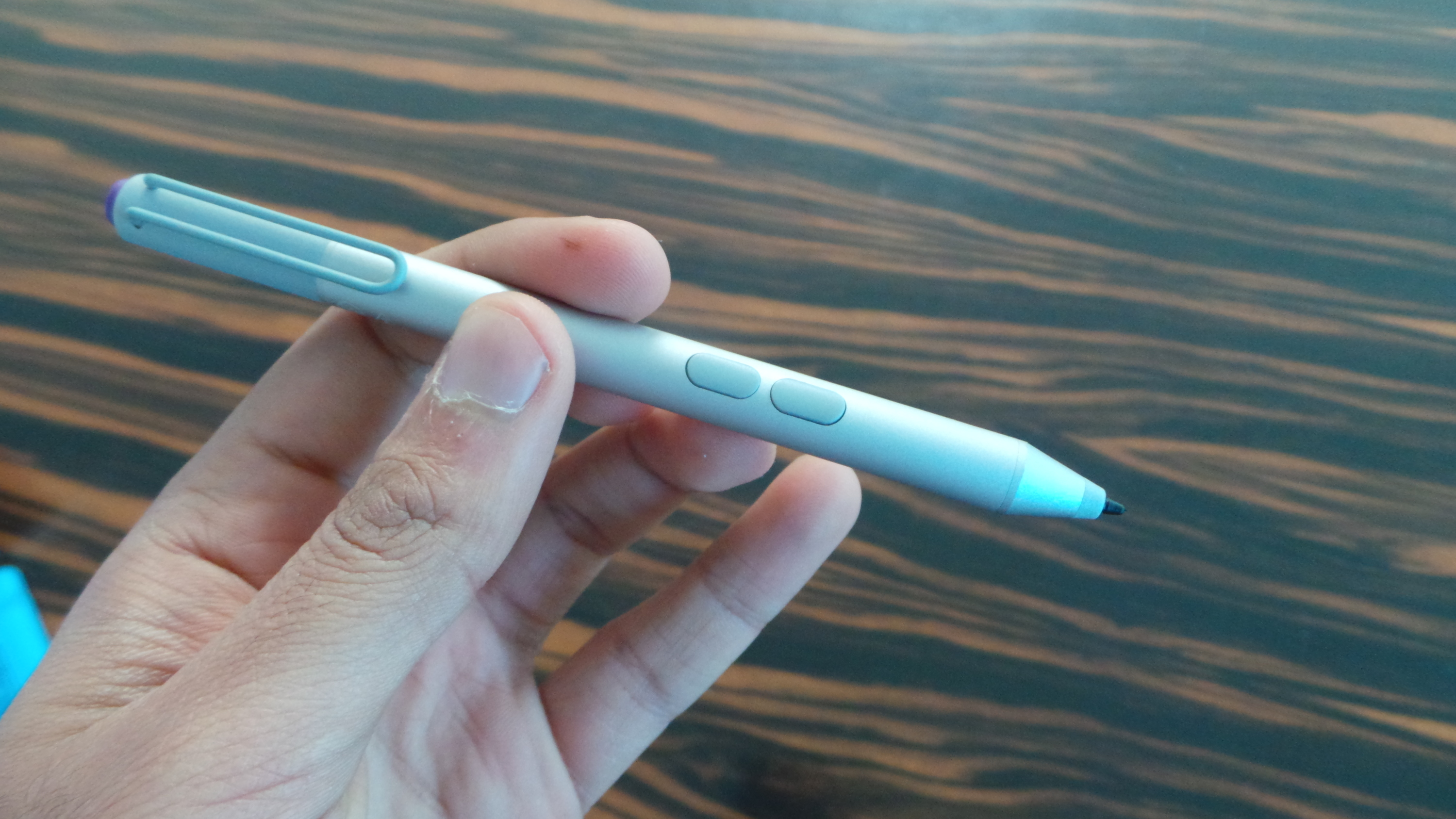
The standout feature is the ability to activate OneNote at any time (even from sleep mode) with a click of the purple button on the end. You can start taking notes immediately, be it in a meeting or lecture, without having to unlock the device, which is a real bonus. Another click will save the note to the cloud and open up a fresh sheet. It's a simple and well-executed idea and optimal for the times when you want to jot down a quick memo.
However, the best bit is the ability to capture any page on the device and annotate it. Simply double click the pen lid and you'll be presented with an option to print screen or select a portion.
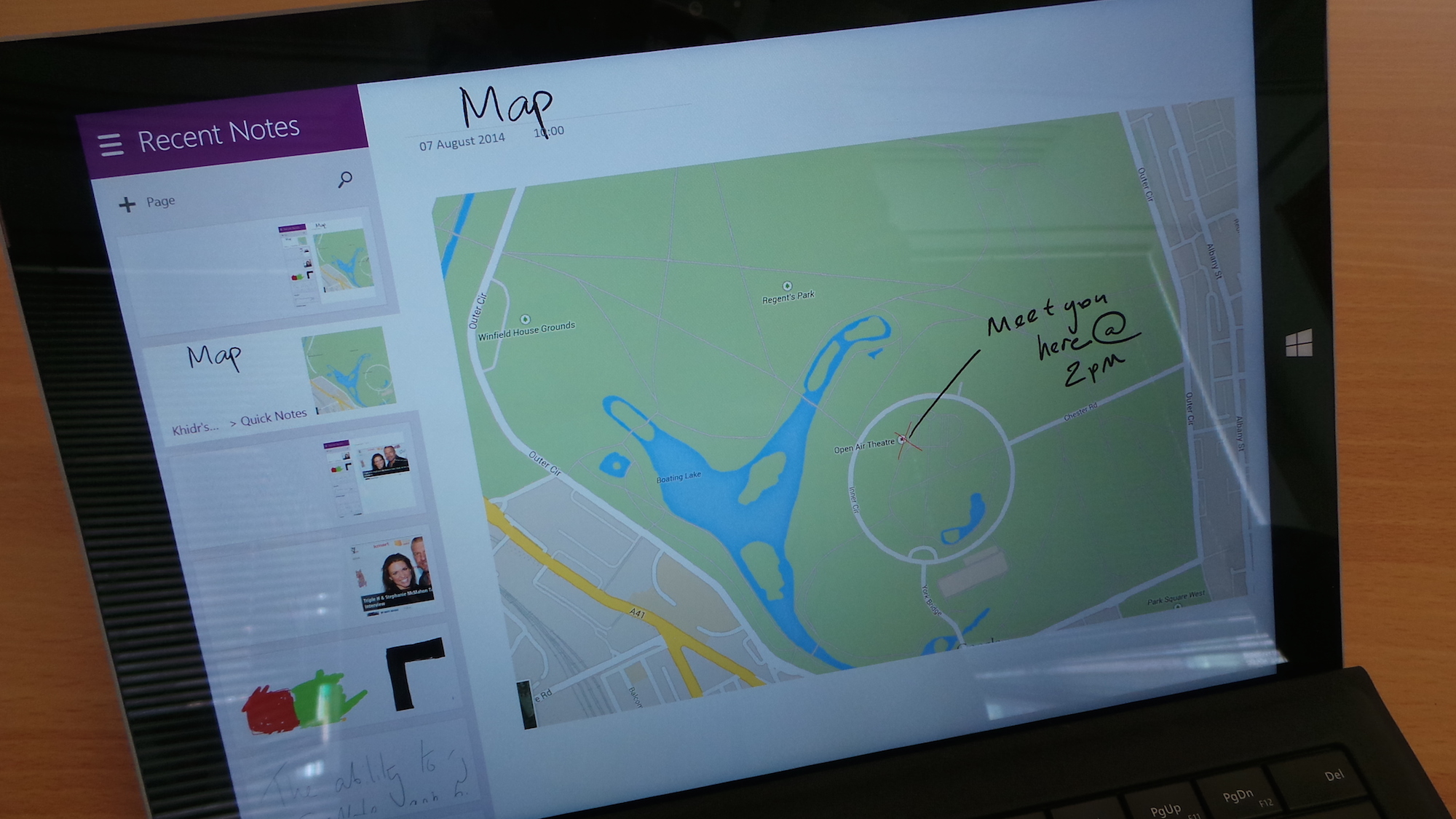
Our only concern is the inability to stash the pen anyway on the cover - so there's a high risk of misplacing it.
Keyboard
Bigger is always better when it comes to keyboards because it means the letters are not cramped and important keys like Shift' and Return' are easy to locate and use.
Microsoft has made the smart decision to scrap the Touch Cover and focus on the mechanical Type Cover, which aims to provide a laptop-like typing experience.
A key feature is the addition of a second magnetic strip on the keyboard. This means you can snap the cover to an angle of six degrees, which makes it much more comfortable to type on.
Typing is improved over its predecessors, but it doesn't replicate the full experience of a desktop and laptop keyboard. Feedback is shallow and each key generates an annoyingly loud thud no matter how gently you press it.
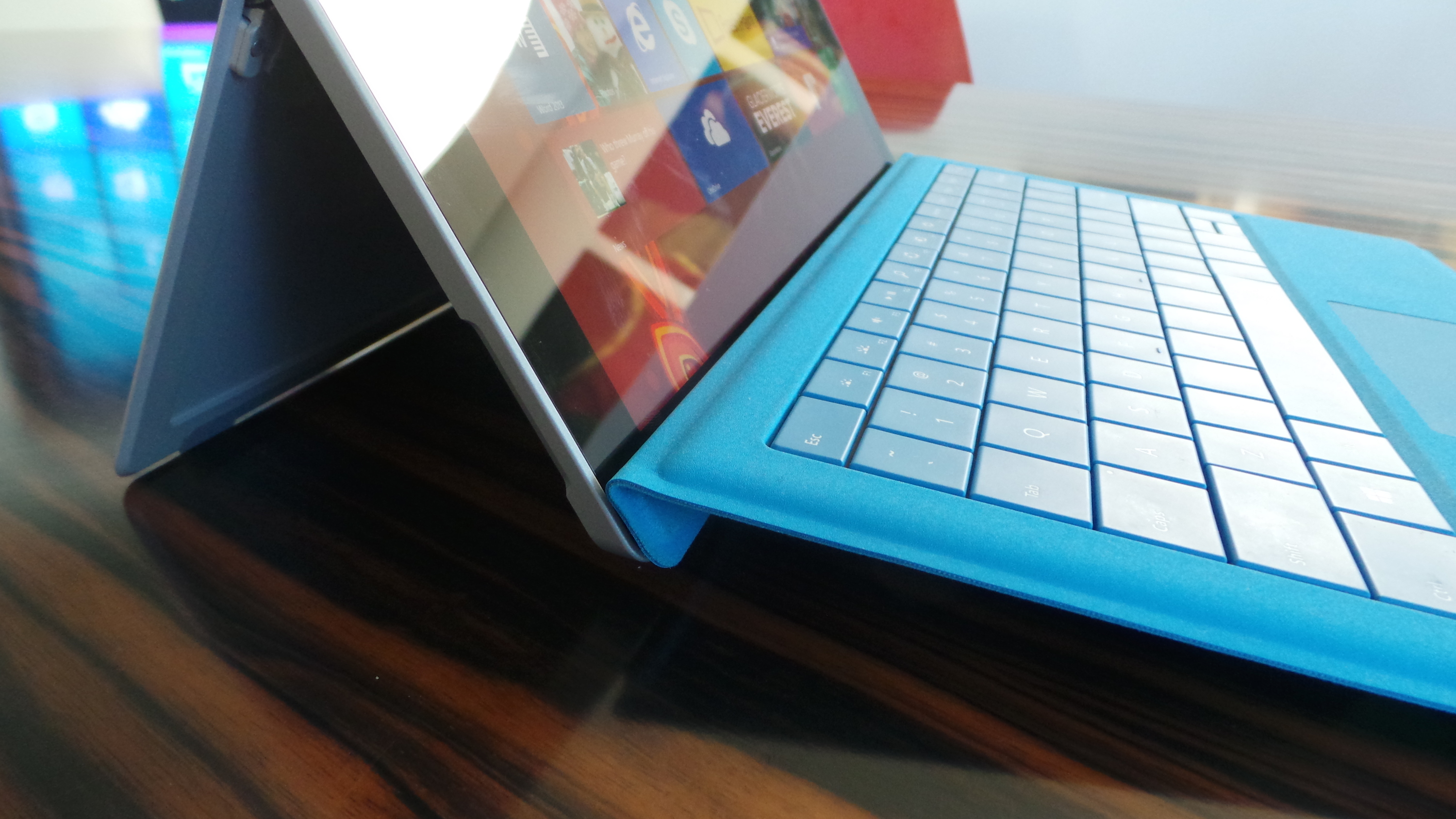
The increased size of the Touch Cover means the Pro 3 has got a step closer to building a usable trackpad. The smooth, glassy finish allows your fingers to glide over the surface and there are properly integrated left-and-right click buttons. Scrolling can get a sticky but it is definitely an improvement. We preferred navigating web pages with the touch screen and only found ourselves using the trackpad when in desktop mode.
For prolonged usage you'll likely want to connect an external mouse to get the most accuracy and prevent fatigue.
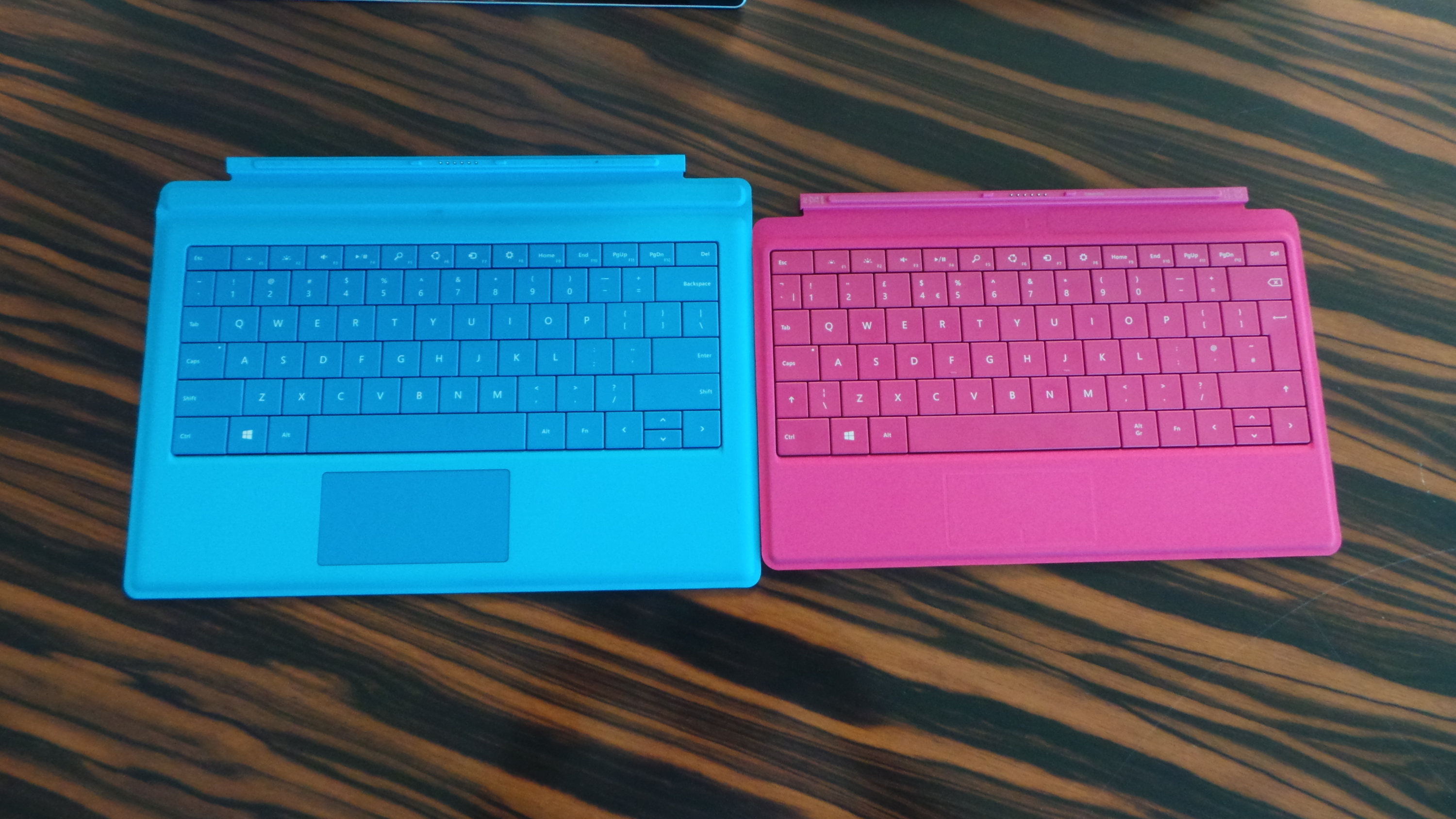
It's worth noting that keyboard accessories from the previous generation Surface (right) device will work with the third generation. But you're going to want the latest keyboard (left) because it's the best.
Kickstand
Based on user feedback, Microsoft created a flexible hinge which can be moved into multiple positions. This is a definite boon for users as previous editions rigidly clicked into one (original Pro) or two places (Pro 2).
The kickstand on the Surface Pro 3 relies on friction, so it has multiple angles (up to 150 degrees). This means it can cater for a multitude of situations from typing out a report on a table to watching a movie in bed.
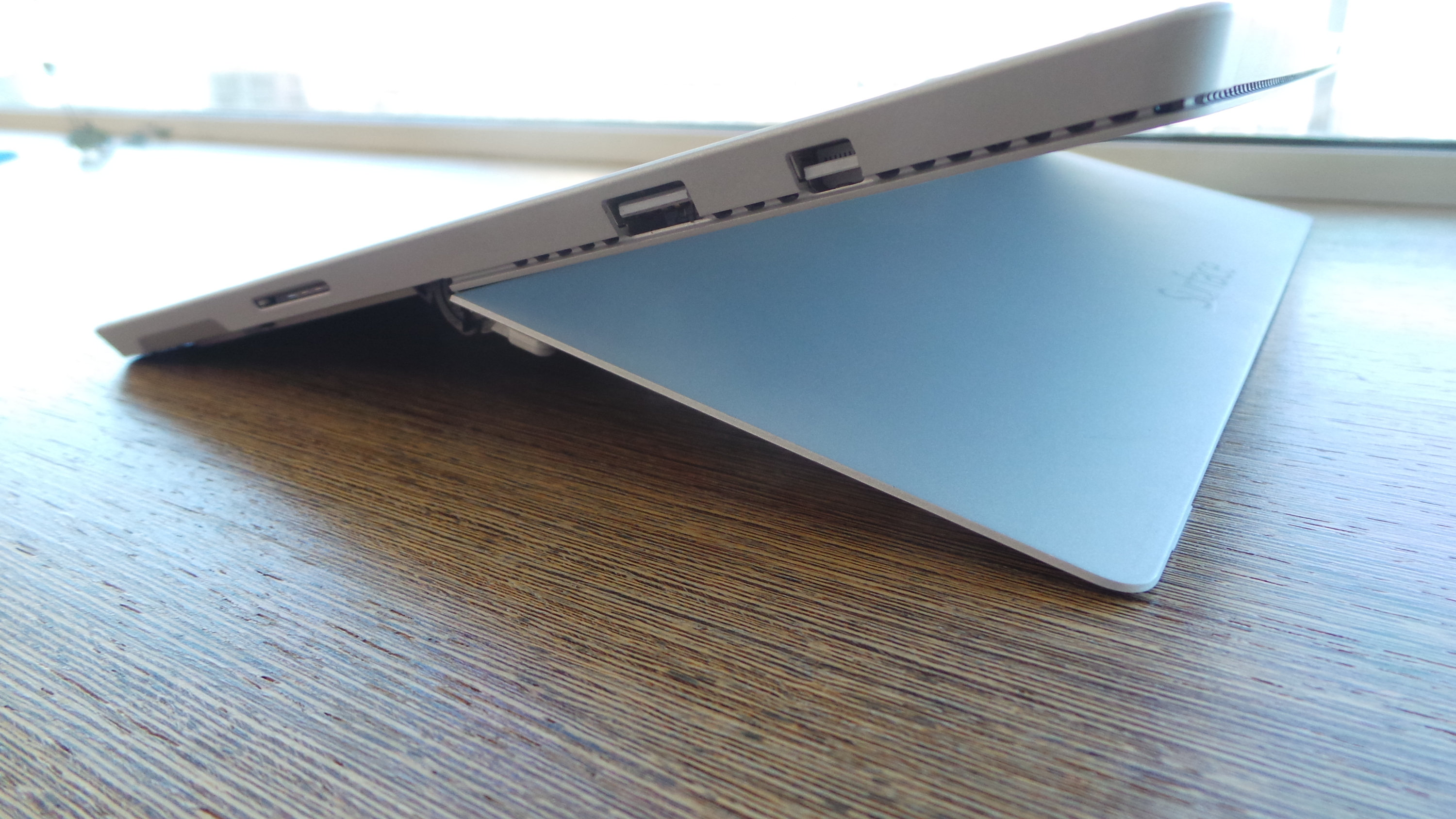
Does the flexibility of the kickstand finally mean you'll be able to use a Surface device on your lap without fear of it backflipping off your knees? Kind-of. Weight is evenly distributed within the chassis and, coupled with the two anchor points for the keyboard, it feels more stable.
Use the lap for prolonged periods of time and the kickstand will dig into your thighs and start to cause discomfort - this is a problem you don't get with regular laptops.
Performance
Our review unit packed close to the top specification available with a Core i5-4300U processor clocked at 1.9GHz with 8GB of RAM and a 256GB SSD.
The Pro 3 posted an overall score of 64/100 in our benchmarks, which surpasses any other Windows tablet we've tested to-date.
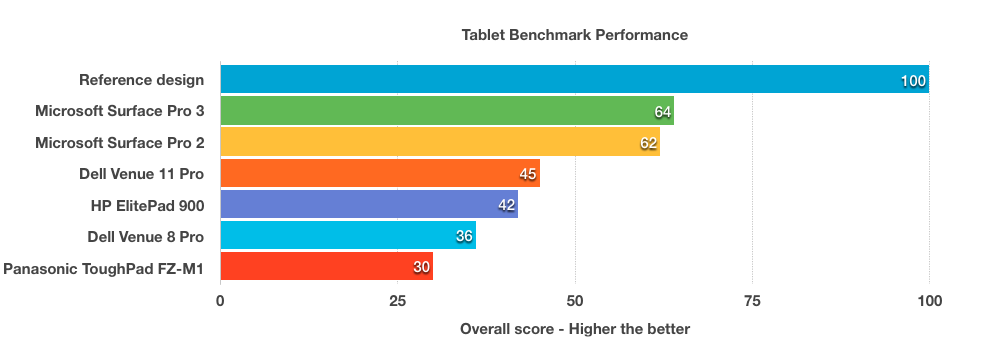
However, the Pro 3 is not quite able to offer the same performance as dedicated laptops such as the MacBook Pro 13in (late-2013) or the Dell E7440. While the multimedia and responsiveness results were good, the overall score was dragged down by a poor showing in the multi-tasking portion.
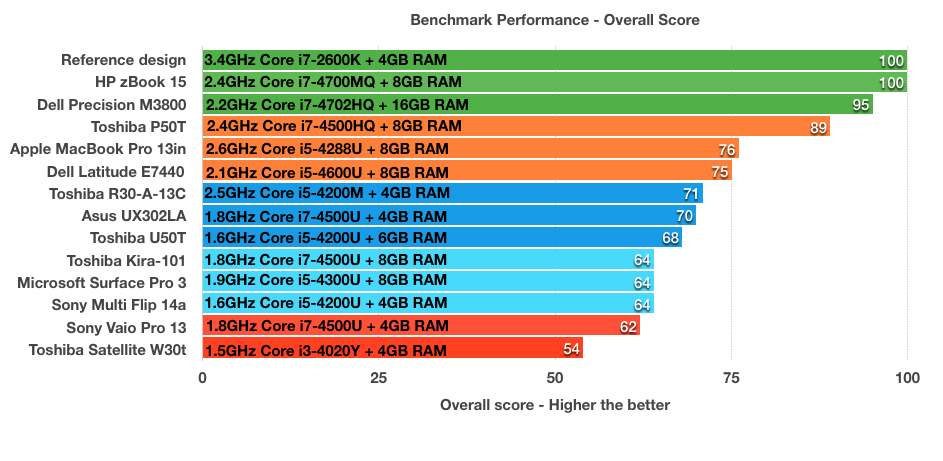
What do these numbers mean? The Pro 3 provides the performance of a mid-range laptop in a tablet form factor. The Core i5 configuration with 8GB of RAM is also capable of functioning as a desktop replacement.
Battery life
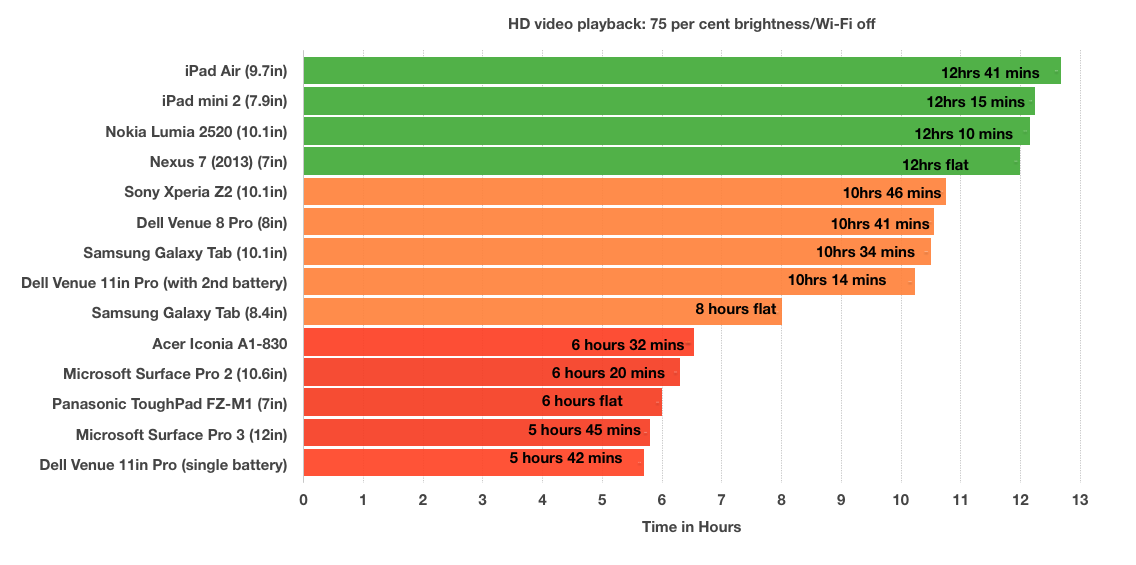
It's possible to get up towards eight hours with moderate use and by lowering the brightness to the 50 per cent mark and below. But, if you're consistently looking for longevity then the Pro 3, it would be hard to recommend this device.
Software
Microsoft preloads a copy of Windows 8.1 Pro so the device is ready for enterprise deployment.
One of the best things about being a Microsoft own-branded product is the lack of OEM bloatware. There are no annoying tools popping up demanding your attention. Instead, Microsoft has pre-loaded a few core apps in the form of Skype, OneNote and Flipboard.
However, the Office suite is not included so customers wanting to use this - which we would imagine most business users would do - will have to purchase a license. While most businesses will have subscriptions to Office 365, inclusion of the core suite would have sweetened the deal, especially for students, who Microsoft is also targeting the device at.
Connectivity
Port selection remains bare. The Surface Pro 3 does have a microSD card reader and Mini Displayport, but the inclusion of 1 x USB 3 connection isn't enough for a device touted as a potential laptop/desktop replacement.
Wireless connection comes in the form of Wi-Fi 802.11ac/a/b/g/n together with Bluetooth 4. There's no option to have 4G connectivity, but this can be mitigated by tethering a device when you are on the move.
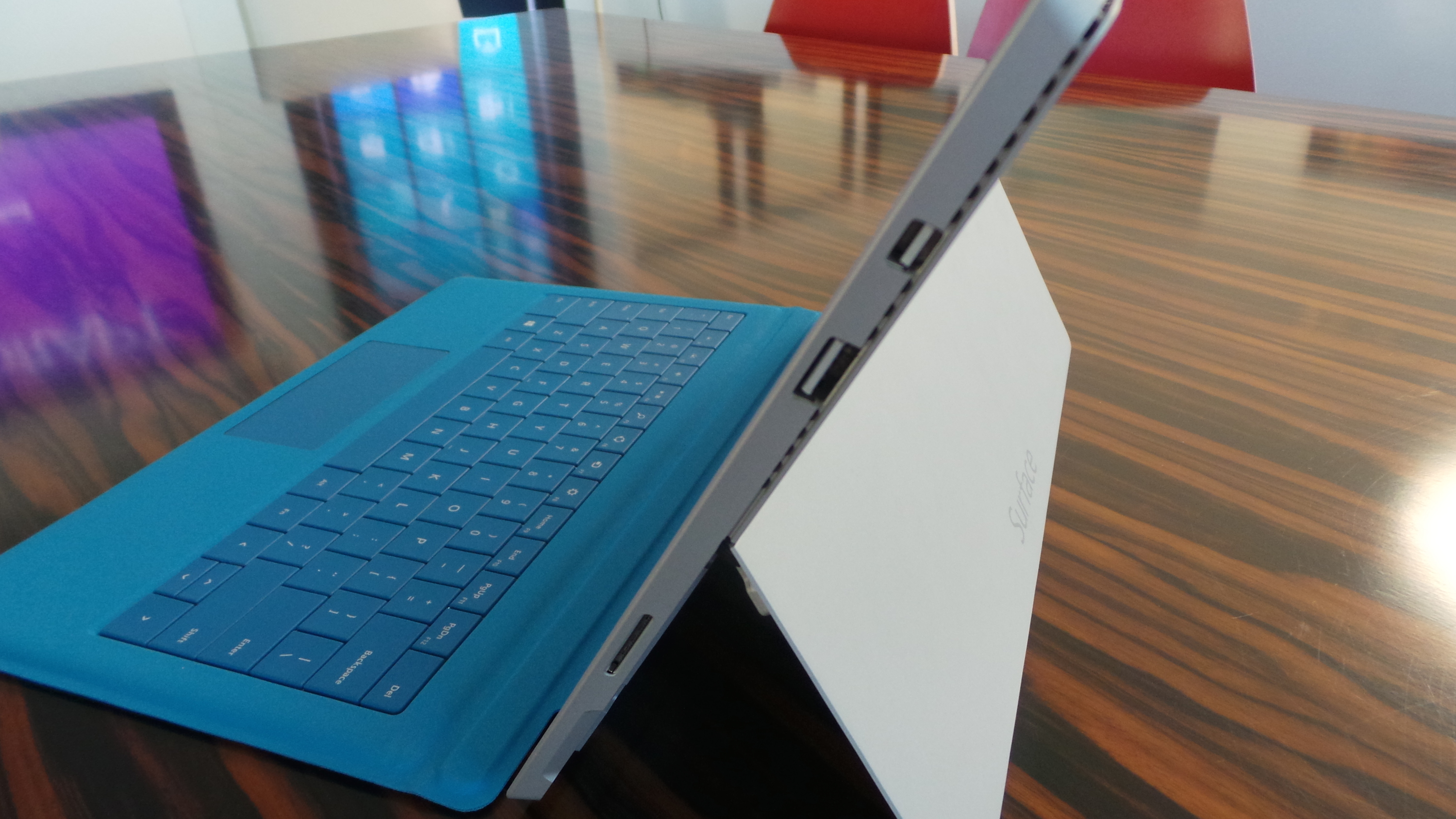
Pricing and warranty
The performance provided by the high-end models of the Pro 3 are reflected in the price. The Core i3 model with 64GB of storage, 4GB RAM and Core i3 chip starts at 639.00. The Core i5 model with 256GB of storage, 8GB RAM and Core i5 chip starts at 1,109. If you want the Core i7 chip, be prepared to pay at least 1,339.
For a limited time, Microsoft is offering a deal for those wanting to buy the 2-in-1.
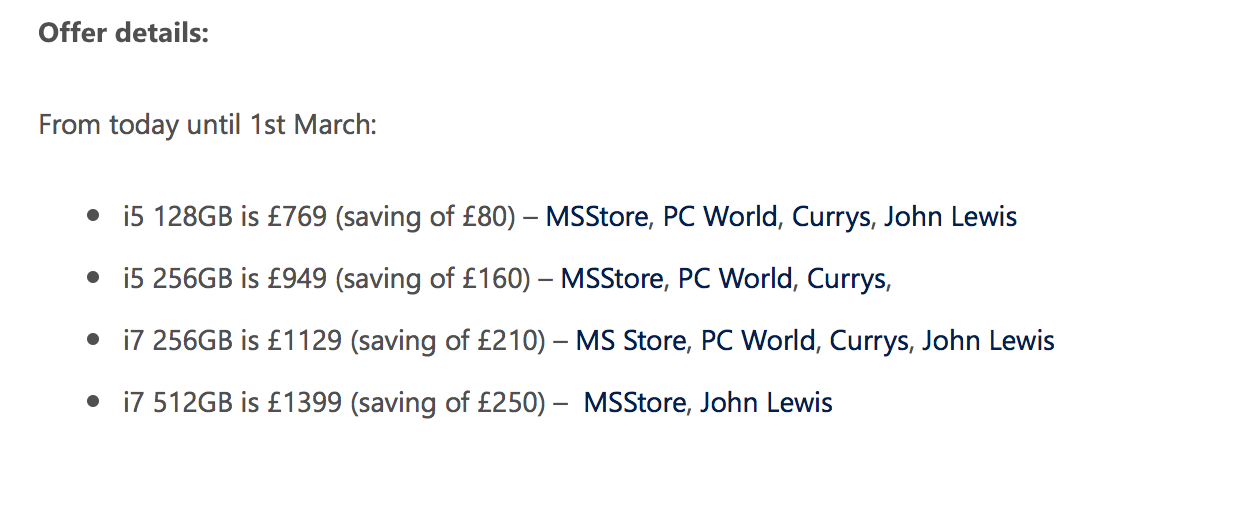
Whichever configuration you choose you have to factor in another 110 for the Type Cover, which is a necessity rather than a nice-to-have. This easily brings the cost of most configurations up towards the 1,500 mark.
Microsoft offers 90 days of technical support - and extended warranties of up to three years can be purchased for businesses. The vendor also provides detailed guides to help with deployment and there are even video tutorials available.
With the lack of long-term support, IT admins thinking about making a bulk purchase of the Pro 3 are going to want to know about the repairability. The tablet received a paltry 1/10 from teardown site iFixit, with the opening procedure described as "delicate and arduous" due the fused glass and copious amounts of glue keeping everything in place. It is possible to replace components such as the SSD, but be warned that it's easy to render the device unusable so it's not something we'd recommend.
iFixit said the reason why the tablet received such a low score was down to the strong adhesive, non-standard connectors and difficulties opening thehardware. Furthermore, when it tried to remove the battery (which is firmly placed), it described the battery pack as being "stuck like amastodon in a tar pit."
Verdict
The Surface Pro 3 is a significant improvement over its predecessors, which were three-star products. We love the design, the pen input is superb and we can't fault the quality of the display. Unfortunately, software doesn't allow you to get the best out of the screen and battery life is sub-par when contrasted with standalone tablets.
The Pro 3 is best suited for design and editing
professionals
who can get the most out of the stylus. It's also suitable for those looking for a desktop replacement, which they can also use on their commute home. We wouldn't be surprised to see C-level execs showcasing the notetaking capabilities during board meetings.
Verdict
Microsoft combines the portability of a tablet with the raw power and input of a laptop. Despite its imperfections the Surface Pro 3 manages to live up to the claim of being a hybrid.
Display: 12in (2160 x 1440) OS: Windows 8.1 Pro 64-bit Processor: 1.9GHz dual-core i5-4300U processor (i3 and i7 variants available)
Memory: 4 or 8GB DDR3L
Storage: 256GB SSD (as reviewed)
Connectivity: Bluetooth 4, Wi-Fi 802.11ac/802.11 a/b/g/n Ports: 1 x USB 3, 1 x mini DisplayPort, 1 x micro-SD card reader
Camera: 5-megapixel front and rear
Other: Pen included, built-in kickstand
Dimensions: 292mm x 201mm x 9.1mm
Weight: 800g (tablet only)
Get the ITPro daily newsletter
Sign up today and you will receive a free copy of our Future Focus 2025 report - the leading guidance on AI, cybersecurity and other IT challenges as per 700+ senior executives
-
 ‘Phishing kits are a force multiplier': Cheap cyber crime kits can be bought on the dark web for less than $25 – and experts warn it’s lowering the barrier of entry for amateur hackers
‘Phishing kits are a force multiplier': Cheap cyber crime kits can be bought on the dark web for less than $25 – and experts warn it’s lowering the barrier of entry for amateur hackersNews Research from NordVPN shows phishing kits are now widely available on the dark web and via messaging apps like Telegram, and are often selling for less than $25.
By Emma Woollacott Published
-
 Redis unveils new tools for developers working on AI applications
Redis unveils new tools for developers working on AI applicationsNews Redis has announced new tools aimed at making it easier for AI developers to build applications and optimize large language model (LLM) outputs.
By Ross Kelly Published
-
 Google layoffs continue with "hundreds" cut from Chrome, Android, and Pixel teams
Google layoffs continue with "hundreds" cut from Chrome, Android, and Pixel teamsNews The tech giant's efficiency drive enters a third year with devices teams the latest target
By Bobby Hellard Published



